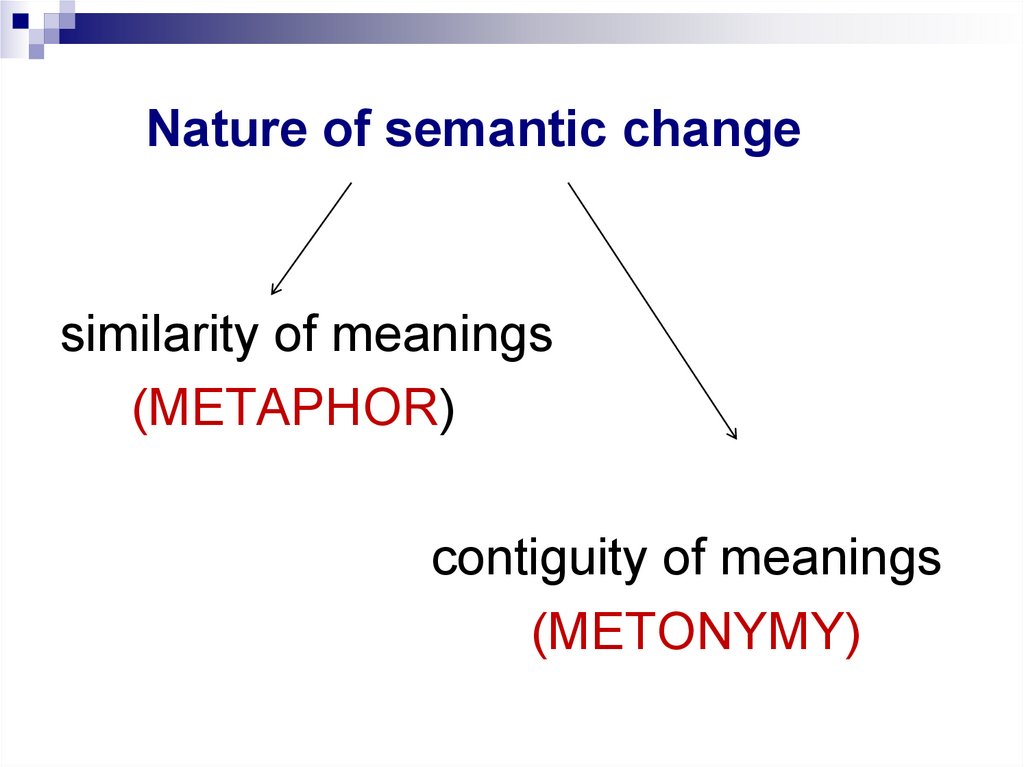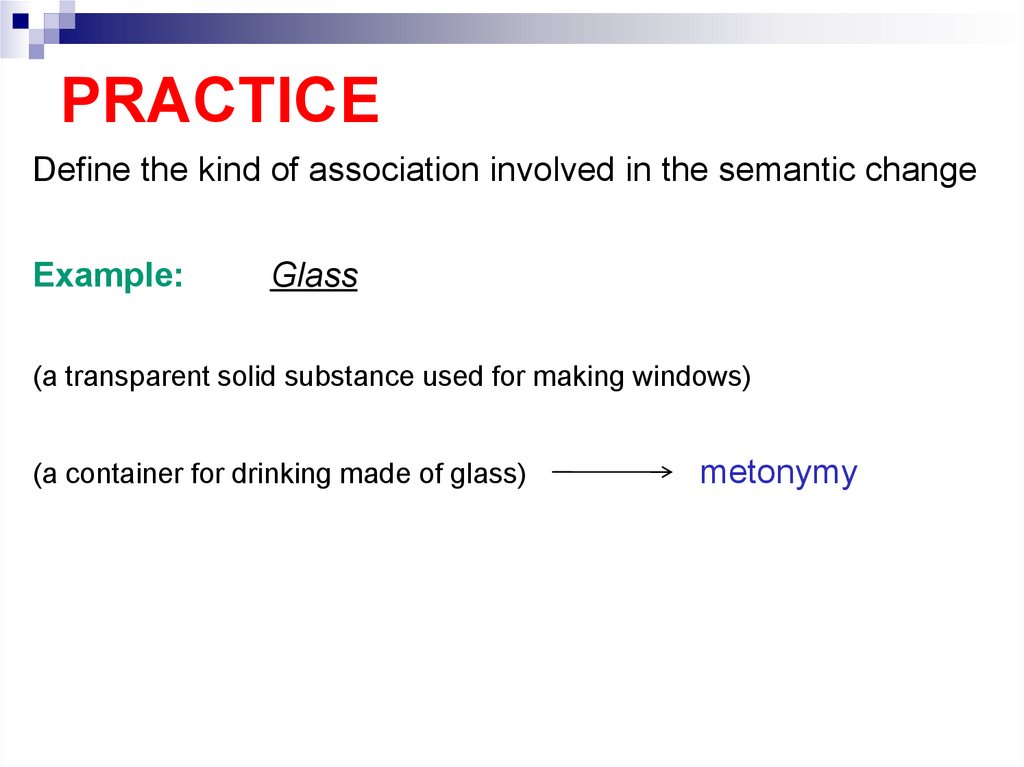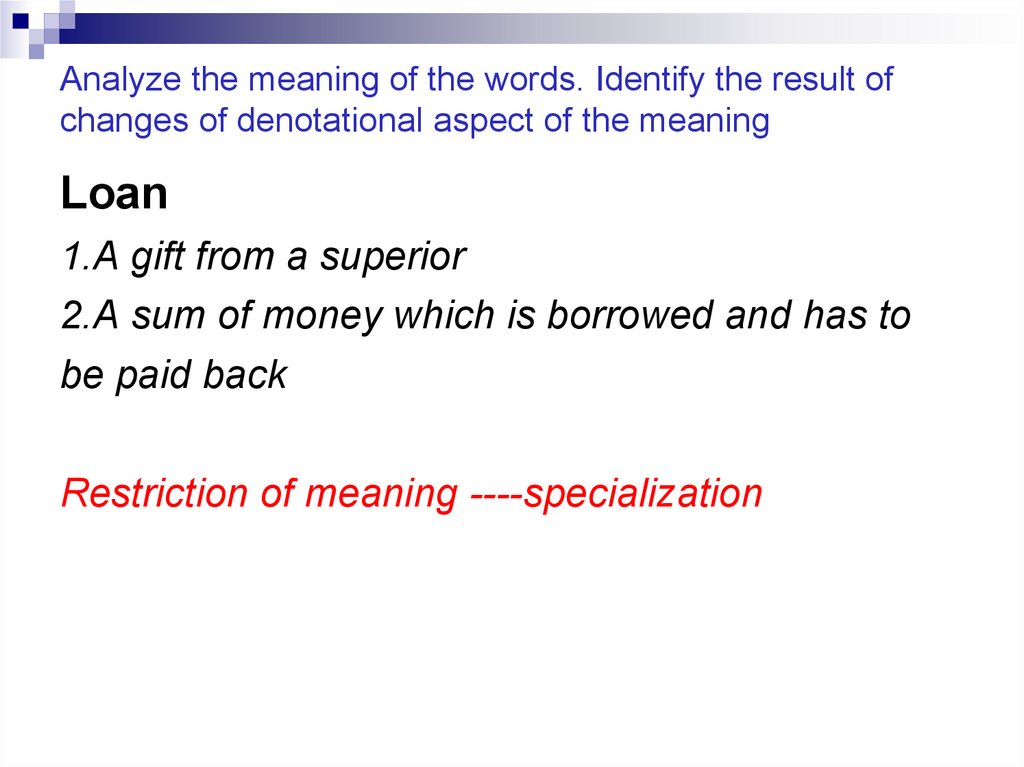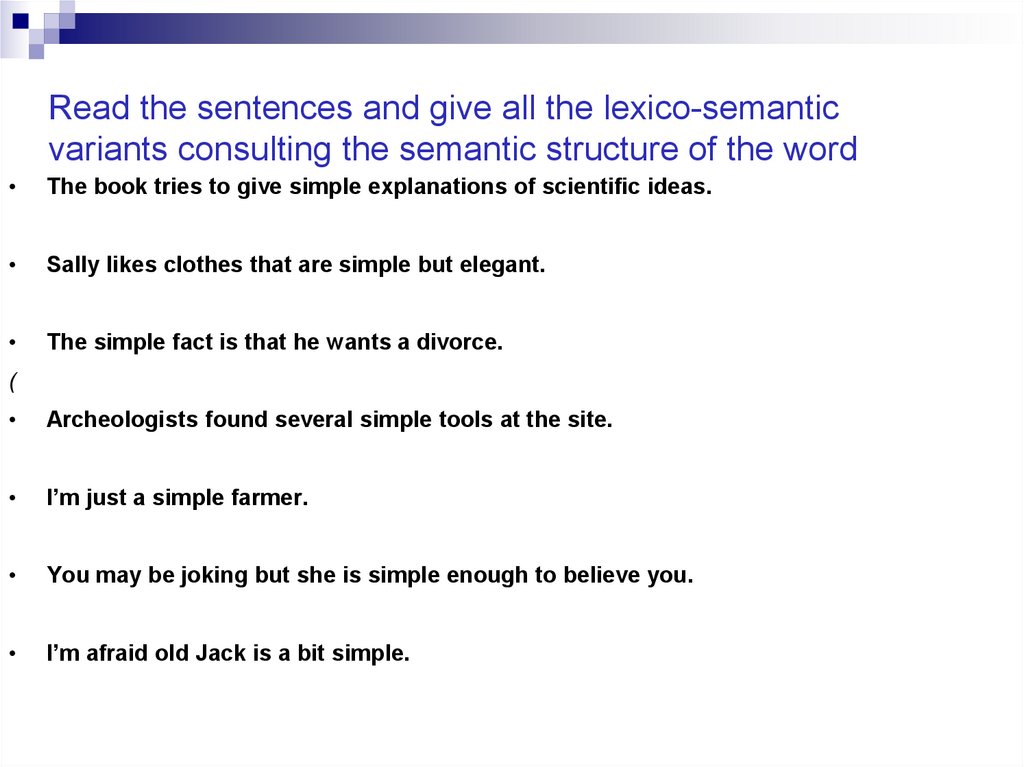Similar presentations:
Polysemy. Semantic Structure of the Word and Semantic Change. Lecture 7
1. Polysemy. Semantic Structure of the Word and Semantic Change Lecture # 7
Grigoryeva M.2.
FIREI
Flame
II
Destructive
Burning
Forest fire
III
IV
Burning smth
V
The shooting
Strong feeling
in a fire
of guns
passion
Camp fire
To open fire
I
main meaning
II-V
secondary meanings
Speech lacking fire
3. Types of semantic components
Leading component – denotative component(expresses the conceptual content of a word)
Additional component- connotative component
(gives more full picture of the meaning of a word)
4.
denotative componentLonely
connotative component
+
alone, without company
+
To glare
sad
(emotive
connotation)
to look
+
lastingly
+
with anger
(connotation of
duration)
(emotive)
5. Semantic Change
development of a new meaningchange of meaning
Causes of Semantic Change
linguistic factor
extra-linguistic (historical) factors
6. Changes in Denotational Meaning
restriction ofmeanings
(narrowing) –
restriction of the
types or referents
denoted by the word
extension of
meanings
(widening) –
application of the
word to wider variety
of referents
OE “hound” – a dog of any
greed
Mo E “hound” – a dog used
in chase
OE “trunk” – the main stem
of a tree
Mo E “trunk” – the body of
anything
7. Changes in Denotational Meaning
specialization - theword with a new
meaning (restricted)
comes to be used in the
specialized vocabulary
generalization – the
word with the extended
meaning passes from the
specialized vocabulary
into common use
OE glide -“to move gently
and smoothly”
Mo E “glide” -to fly with no
engine
OE “salary” – money given to
soldiers to buy salt with
Mo E “salary” – money paid
to clerks
8. Changes in Connotational Meaning
pejoration(degradation)
– acquiring some
negative derogatory
emotive charge
amelioration
(elevation) –
improvement of the
connotational
component
. OE “boor”- a villager, a
peasant
Mo E “boor” – a clumsy or illbred fellow
OE “minister” – a servant,
an attendant
Mo E “minister” – a civil
servant of higher rank
9. Polysemy
The ability of words to have more than onemeaning is described as polysemy
A word having several meanings is called
polysemantic
Words having only one meaning are called
monosemantic
(mainly scientific terms)
10. BRIGHT
Bright colour (dress, flower)intensive in colour
Bright metal (gold, silver)
shining
Bright student (boy)
capable
Bright face (smile, eyes)
happy
11.
V.V. VinogradovMeaning and Usage
Meanings are fixed and common for all people
Usage is a possible application of one of the meanings
of a polysemantic word
Meaning is not identical with usage
12. Diachronic Approach to Polysemy
primary meaning – the first meaning withwhich the word appeared in the language
secondary meaning – could appear only
after the primary meaning
derived meaning – could not have
appeared before primary meaning was in
existence and is dependent on it
13. Heart
• The organ that pumps bloodHe has a weak heart.
• The important / central issue
The heart of the matter
• Kindness
She has a kind heart and helps people
• One’s deepest feelings
He knew in his heart that he was wrong
14. Smart
He is really smart, he is at the top of the class.
Intelligent, able to think well
The child made a smart remark to his father and was
sent to bed immediately.
Rude
• He wore a smart suit and new leather shoes.
fashionable, neat
15. Nature of semantic change
similarity of meanings(METAPHOR)
contiguity of meanings
(METONYMY)
16. Similarity of Meanings- METAPHOR
Similarity of Meanings- METAPHOR
appearance of a new meaning as a result
of associating two objects (phenomena,
qualities, etc.) due to their resemblance
17. Metaphor
similarity of shapeEX head of a cabbage, teeth of a saw, bottleneck
similarity of position
EX foot of a page (of a mountain)
similarity of function, behavior
EX a bookworm, a (minute) hand
similarity of colour
EX orange, hazel, chesnut
complex similarity
EX a leg of a table – similarity in shape, position, function
18. Contiguity of Meanings - Metonymy
association of two referents one of whichmakes part of the other or is closely
connected with it
19. Types of Metonymy
the material of which an object is made may become thename of the object
EX an iron, a mink (“mink coat”)
the name of the place may become the name of the
people or of an object placed there
EX the city was exited, the White House (US administration)
names of musical instruments may become names of
musicians when they are united in an orchestra
EX the violin, the piano
20. Types of Metonymy
names of inventors often denote things they inventedEX watt, om
geographical names may be used for things produced there
EX china (porcelain), holland (linen fabrics)
the name of a painter is used for his masterpieces .
EX a Matisse (a painting by Matisse)
the name of some person may become a common noun
sandwich (Lord Sandwich), boycott (the Boycotts)
21. Secondary Ways of Semantic Changes
hyperboleirony
euphemism
taboo
litotes
22. Hyperbole
the exaggerated statement which shouldnot be understood literally as it expresses
an emotional attitude of a speaker to what
he is speaking about
EX I haven’t seen you for ages
It’ll be the death for me
23. Irony
the expression of one meaning by wordsof opposite sense, usually it is done for the
purpose of ridicule
EX How nice! (when you are angry)
A pretty mess you’ve done of it!
24. Euphemism
referring to something unpleasant by usingmilder words and phrases so that a
formerly inoffensive word receives a
disagreeable meaning
EX. to pass away = to die
25. Taboo
the case when it is prohibited topronounce a word and it is replaced by
another word or a word-combination
EX nigger- Afro American
26. Litotes
expressing the affirmative by the negativeof its contrary
EX. not bad = good
not small = great
27. PRACTICE
Define the kind of association involved in the semantic changeExample:
Glass
(a transparent solid substance used for making windows)
(a container for drinking made of glass)
metonymy
28.
1. Jean2.The wing of a bird
3.The foot of a person
4.Copper
Jeans
the wing of a building
the foot of a mountain
copper
29.
1. Jean(Heavy cotton cloth)
Jeans
(Trousers made of denim)
metonymy
2.The wing of a bird
the wing of a building
metaphor
3.The foot of a person
the foot of a mountain
metaphor
4.Copper
(metal)
copper
(coin)
metonymy
30. Analyze the meaning of the words. Identify the result of changes of denotational aspect of the meaning
Loan1.A gift from a superior
2.A sum of money which is borrowed and has to
be paid back
Restriction of meaning ----specialization
31.
Girl“A small child of either sex”
“A small child of female sex”
Camp
“A place where troops are lodged in tents”
“A place where people live in tents or huts”
Room
‘Space”
“A part of division of a building”
32.
Girl“A small child of either sex”
“A small child of female sex”
Restriction of meaning---specialization
Camp
“A place where troops are lodged in tents”
“A place where people live in tents or huts”
Extension of meaning-----generalization
Room
‘Space”
“A part of division of a building”
Restriction of meaning---specialization
33. Analyze the meaning of the words. Identify the result of changes of connotational aspect of the meaning
Example:Villian
1.”a feudal serf”
2. ‘a person guilty or capable of a crime”
The word acquired a derogatory emotive charge----deterioration of meaning
34.
Knight‘man servant”
“noble man”
Cunning
“possessing erudition or skill”
“clever at deceiving”
Fond
“foolish, infatuated (лишившийся рассудка)”
“loving, affectionate”
35.
Knight‘man servant”
“noble man”
Amelioration
Cunning
“possessing erudition or skill”
“clever at deceiving”
Deterioration
Fond
“foolish, infatuated (лишившийся рассудка)”
“loving, affectionate”
Amelioration
36. Read the sentences and give all the lexico-semantic variants consulting the semantic structure of the word
The book tries to give simple explanations of scientific ideas.
Sally likes clothes that are simple but elegant.
The simple fact is that he wants a divorce.
(
Archeologists found several simple tools at the site.
I’m just a simple farmer.
You may be joking but she is simple enough to believe you.
I’m afraid old Jack is a bit simple.
37. Read the sentences and give all the lexico-semantic variants consulting the semantic structure of the word
The book tries to give simple explanations of scientific ideas.
(easy to understand)
Sally likes clothes that are simple but elegant.
(plain without decoration)
The simple fact is that he wants a divorce.
(not complicated by anything else)
Archeologists found several simple tools at the site.
(with only one or two parts)
I’m just a simple farmer.
(ordinary)
You may be joking but she is simple enough to believe you.
(easily tricked)
I’m afraid old Jack is a bit simple.
(weak-minded)
38. Define the meaning
1. I walked into park, fell flat upon the grass and fell asleep.2. I thrust my hand through the bars, the dog liked me.
3. At the end of a long bar, leaning against the counter was a slim
pale individual wearing a red bow-tie.
4. I sat down with my head in my hands.
5. The minute hand jumped at twelve.
6. I began to search the flat for the key.
4. The authority of his voice set the key for the newspaper report.






































 english
english








